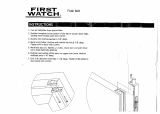
Door Hardware
Installation Instructions
Single Cylinder Deadbolt
NOTE: Deadbolts t doors 1-3/4” to 2-1/4” thick.
For thicker doors, please call customer service.
For
Assistance
Call:
1-800-522-7336
8 am - 5 pm, Monday - Friday, MST
Carefully unpackage all the components and place them within
easy reach. Find Figure #1 on page 4 of these instructions for
a listing and drawing of each component. Detach Figure #1 and
place beside the components for easy refernce. If your door is al-
ready prepped (pre-drilled), start at Step 4. If your door has not
been prepped for installation, you will need a #2 Phillips screw-
driver, a drill, a 2-1/8” hole saw, a 1” drill bit (spade or forstner
style), a 7/8” drill bit, a 1/8” drill bit, a razor knife, a chisel and a
pencil, tape and an awl (or nail).
Step 1
Door Preparation For Deadbolt
A) Locate the Door Preparation Template which is included
with these instructions. Fold the template along the “edge-
of-door” line. Important: Before positioning the template,
make sure that you are aligning it on the non-hinged edge of
the door. Carefully position the template so that the narrow
portion of the template wraps around the edge of the door, and
the large portion of the template remains on the face of the
door, see Figure #2. Slide the template up or down on your
door so that the centerline is located at a height that is both
comfortable to use and attractive in appearance. Typically, this
will be approximately 36”-38” from the oor. Once you have
chosen the height, tape the template to the door.
B) Determine the backset of the deadbolt latch (Part #1) by
checking the marking on the deadbolt latch itself. If the latch
is not marked, measure the latch between points A and B to
determine the backset, as shown in Figure #2. The backset
will either be 2-3/8” or 2-3/4”. Once you know your backset,
nd the point on the template where the centerline crosses
the vertical line that corresponds with the correct backset.
Using the awl (or nail) mark this point, making sure that it is
marked well enough to see on the door once the template is
removed.
C) Follow the centerline around the edge of the door and using
a pencil, extend the centerline onto the edge of the door. The
mark should be horizontal to the oor. Once this mark is
made, you may remove the template from the door.
D) Measure the thickness of the door. Doors vary in thickness
depending on the manufacturer. Determine the distance from
the center to the edge of the door (half the thickness of the
door). Using the awl (or nail), mark a point on the edge of the
door where the centerline pencil mark (from Step 1C) and the
center of the edge of the door meet (half the thickness), see
Figure #3.
v
v
v
v
&ORv"ACKSET
&ORv"ACKSET
#ROSS"ORE
(OLEv
$IAMETER
-ARKFROM
3TEP"
%DGE"ORE
(OLEv
$IAMETER
-ARKFROM
3TEP$
$OOR4HICKNESS
&ACEPLATE
-ORTISE
!REA
#ENTERLINE
-ARKFROM
3TEP#
-INIMUM
vTOCENTER
LINEOFDOOR
KNOBCROSS
BOREHOLE
Step 2
Drill the Door
A) Using the 2-1/8″ hole saw, drill the cross bore hole centered
on the mark made on the face of the door from Step 1B. See
Figure #3. Important: To avoid splintering or marring the
door, drill from one side of the door until the pilot bit comes
through the door. Then drill from the other side of the door,
using the hole made by the pilot bit as your guide until the
cross bore hole is complete.
B) Using the 1″ bit, drill the edge bore hole centered on the mark
made on the edge of the door where the centerline and center
thickness met from Step 1D, see Figure #3. Important:
Make sure that you drill a full 3-1/2″ deep to accommodate
the overall length of the 2-3/8″ latch. If you are using a 2-3/4″
backset latch, then the overall depth must be at least 3-3/4″.
Figure #3
"
!
4EMPLATE
%DGE
OF
$OOR
&ACEOF$OOR
#ENTERLINE
Page 1 - PK133
Figure #2










